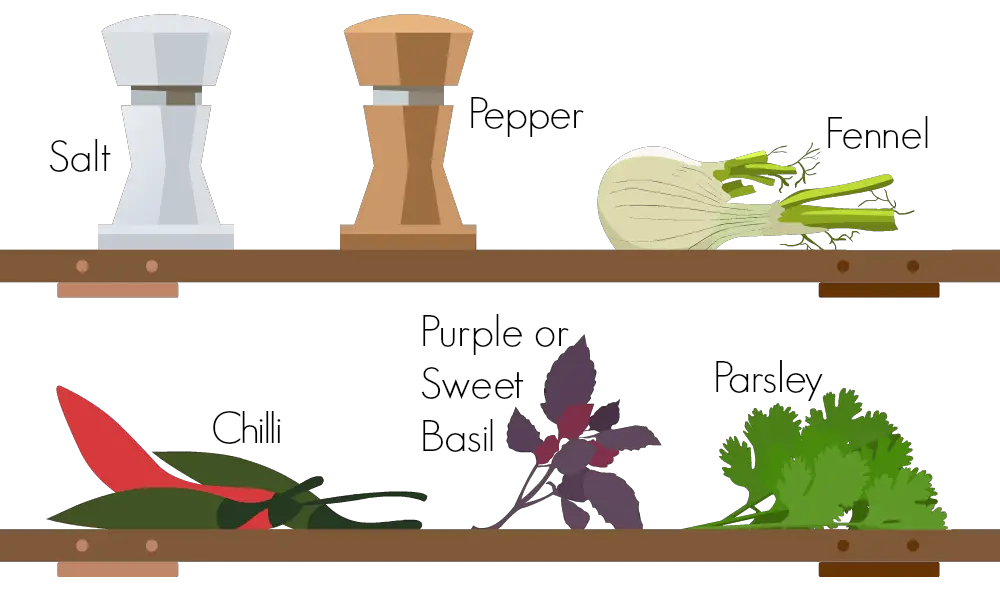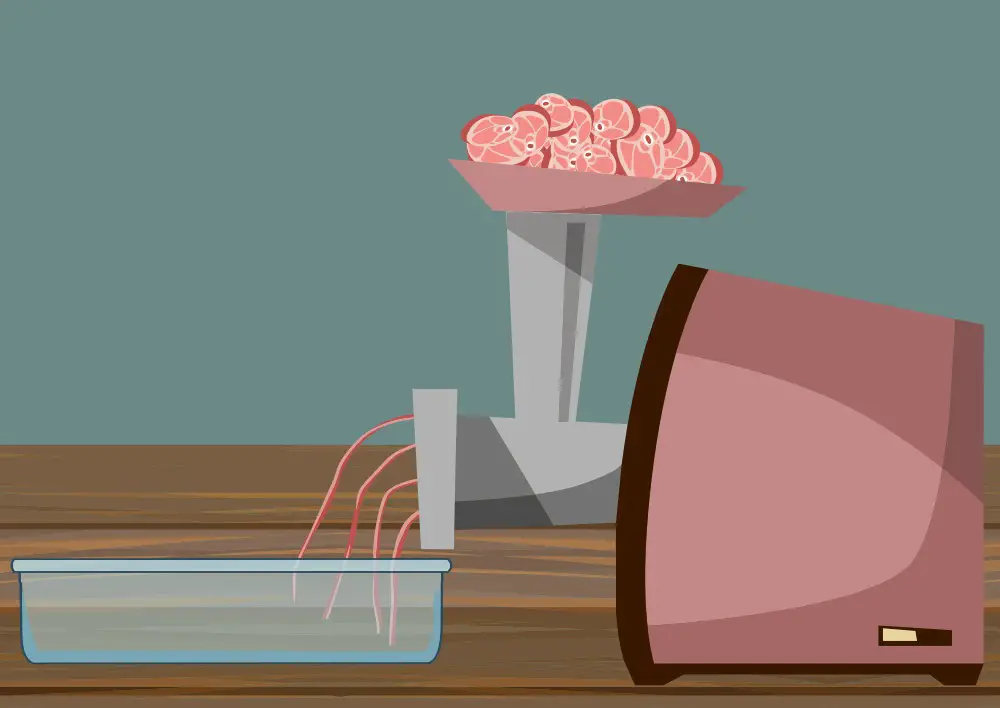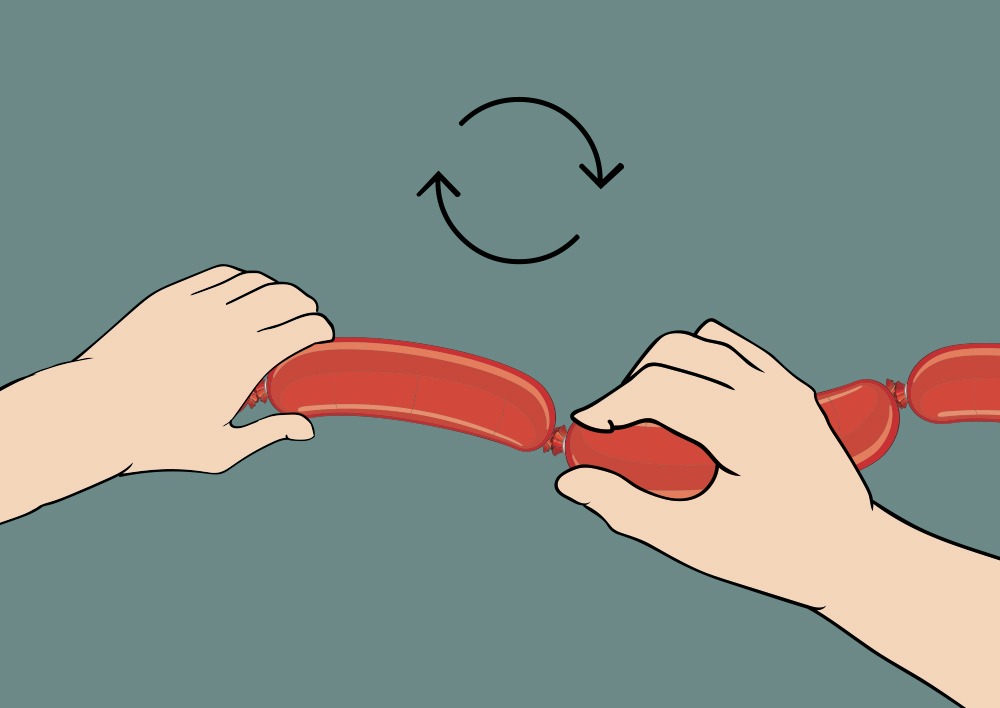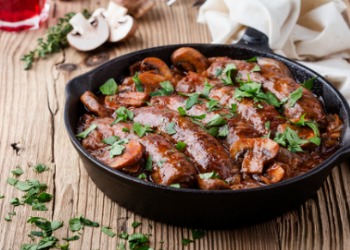
Everything you’ve ever wanted to know about Italian sausage.
On one page.
So you want to learn how to make Italian sausage, or salsiccia as they call it in Italy? Great idea. It’s hard to beat the delicious taste and texture of a homemade sausage. This isn’t your average how-to guide. The is the ultimate illustrated guide!
With this page, you’re armed and ready to dive into making Italian sausage. Let’s get started!
What’s Italian Sausage?
In the U.S. Italian sausage most “often refers to a style of pork sausage which is seasoned with fennel or anise as the primary seasoning. In Italy, however, a wide variety of sausages are made, many of which are quite different from the product commonly known as ‘Italian sausage’ in North America.” Source.
As the name suggests, Italian sausage originates from Italy. Who would have guessed? What’s not so obvious is which part of this food loving nation invented it. That all depends on the type of sausage in question. There are dozens of variations of recipes, each one stemming from a different region.
In the United States the sausages you can buy in supermarkets often derive from Sicily in terms of flavours; however, the original version from Sicily contains coarser meat and also has a higher percentage of fat.
Common Seasonings Used in Italian Sausage

Popular flavors in the U.S.
How it’s made in Italy
The Italians are well known for using every part of the pig. Around Christmas, throughout the country pigs are killed. The pork meat is then transformed into sausage, ham, salami and many other meats. The internal organs, the flesh, the ears – everything has its use.

Every region of Italy has it’s own special recipe handed down through the generations. However, some themes remain constant throughout the country. The pig is chopped into pieces, then either salt and pepper is added or chilli. The meat sits for 24 hours to absorb the seasonings then it’s stuffed into sausage casings.
If you ever make it to Italy, you’ll find the further south you head, the hotter the seasoning tends to get. So once you hit Calabria and Sicily be wary of locally made sausage if you can’t handle hot foods.
Nutrition in an average 5″ Italian sausage

Calories
234
Fat
19g
Carbohydrates
2.9g
Protein
13g
Types of Italian Meats
Coppa
A rustic cold cut made from the dry-cured pork shoulder or neck.

Lonza
Cured pork loin or butt.

Mortadella
An over-sized luncheon meat made from very finely ground pork.

Nduja
A fiery, spreadable pork salami from Calabria. Perfect on pizza!

Pancetta
Cured pork belly that needs to be cooked. Often cubed or sliced wafer thin.

Prosciutto
Cured, thinly sliced ham often served uncooked.

Sopressata
A cured, bold flavoured salami made with black pepper or chilli

Toscano Salami
A very lean, dry salami with hunks of fat, peppercorns and garlic.

Culatello
A delectable cured salami traditionally made from the fillet of the pig’s thigh.

Italian sausage ingredients table
Mamma Mia! It’s time to make some Italian sausage. To start, let’s work out what ingredients you need. We’ve got you covered with our super helpful ingredients table below.
Flavour: Mild
| Pork | Salt | Pepper | Fennel | Parsley |
|---|---|---|---|---|
| 1 lb | 0.4 Tbsp | 0.2 Tbsp | 0.5 Tbsp | 0.6 Tbsp |
| 2 lb | 0.8 Tbsp | 0.4 Tbsp | 1.0 Tbsp | 1.2 Tbsp |
| 5 lb | 2.0 Tbsp | 1.0 Tbsp | 2.5 Tbsp | 3.0 Tbsp |
| 10 lb | 4.0 Tbsp | 2.0 Tbsp | 5.0 Tbsp | 6.0 Tbsp |
| 20 lb | 8.0 Tbsp | 4.0 Tbsp | 10.0 Tbsp | 12.0 Tbsp |
| 30 lb | 12.0 Tbsp | 6.0 Tbsp | 15 Tbsp | 18 Tbsp |
Flavour: Hot
| Pork | Salt | Pepper | Fennel | Parsley | Chilli flakes |
|---|---|---|---|---|---|
| 1 lb | 0.4 Tbsp | 0.2 Tbsp | 0.5 Tbsp | 0.6 Tbsp | 1.0 tsp |
| 2 lb | 0.8 Tbsp | 0.4 Tbsp | 1.0 Tbsp | 1.2 Tbsp | 2.0 tsp |
| 5 lb | 2.0 Tbsp | 1.0 Tbsp | 2.5 Tbsp | 3.0 Tbsp | 5.0 tsp |
| 10 lb | 4.0 Tbsp | 2.0 Tbsp | 5.0 Tbsp | 6.0 Tbsp | 10.0 tsp |
| 20 lb | 8.0 Tbsp | 4.0 Tbsp | 10.0 Tbsp | 12.0 Tbsp | 20.0 tsp |
| 30 lb | 12.0 Tbsp | 6.0 Tbsp | 15 Tbsp | 18 Tbsp | 30.0 tsp |
9 steps to make Italian sausage
1. Prepare the casings

Casings come packed in salt so you’ll need to rinse them first. Run some water over and through the casings to remove any residual salt, then place them in a bowl of water while you get everything else set up. It is always a good idea to drape one end of the casing over the side of the bowl or you’ll have a nightmare trying to find each opening.
- Recommended casing size: Hog 35-38 for a BIG sausage or choose 32-35 casings for a supermarket sized sausage.
Tip: Casings can’t be reused once they’ve been opened.
2. Select the right meat

When making Italian sausage it’s essential that you use meat from the shoulder of the pig. This is an area from the back down to the front elbow. The meat is ideal for making sausage as the fat:meat ratio is just what you need.
Expert tip
When buying meat at the butcher, ask for picnic shoulders. These will cost you less than a whole shoulder which contains a special cut of meat used for capicola. You will be grinding meat for sausage so the whole shoulder is an unnecessary expense.
3. Chill everything

Pop your meat and sausage making equipment in the freezer. You want the meat to be firm but not frozen solid. Why is this important? Because the fat needs to stay hard during processing. If it softens you’ll struggle to create an emulsion with the meat and fat. The end result? A sausage that has the fat separated from the meat and nobody wants that.
4. Chop the pork

Slice the pork off the bone ensuring you keep some of the fat. If you come across any nasty looking sinew then remove it.
Cut the meat into pieces that are a suitable size for the opening of your meat grinder. A size of 1-2” is usually a good rule of thumb.
Place the meat in the fridge for 30 minutes once it’s all chopped up.
5. Grind the pork

Select a coarse holed plate for your meat grinder as this is preferable for Italian sausage. Grind the meat into a bowl and place in the fridge while you get your seasonings ready.
If you need a meat grinder you’ll do well to check out this meat grinding resource.
6. Mix in the seasonings

Using your hands, mix the meat with your seasoning and ensure everything is well combined. You can also use a powerful mixer to combine the ingredients if you have one.
At this stage take a sample of the meat and cook it in a skillet until browned. Taste test to make sure the flavour is right. Add seasonings as required.
7. Stuff the sausages

Now you’re going to stuff the sausages into their casings. If you have two people for this job it will make life much smoother. One loads in the meat while the other holds the casings.
Attach a casing to the end of the nozzle and tie off the end. Now start pumping meat into the casing, being careful to not let any air get into the casing. There is a balancing act between having too much air and not enough air.
Too much air = a poorly formed sausage
Too little air = the casing will burst
Stop filling the casing with about 3” to spare at the end. Now you can tie off the end. Repeat this step until all the meat has been stuffed into casings.
Special Tip
We use 35-38mm casings for Italian sausage which allow you to make a large banger. If you prefer a supermarket sized sausage then choose a 32-35 casing.
8. Create links

Measure 8” and squeeze the meat apart then twist the sausage towards you. You have created your first sausage! Now measure another 8” and twist the sausage away from you. It is really important to alternate which way you turn the sausage. This will stop the links unravelling. Prick your sausages if you see any air bubbles.
We usually make 8″ sausages but you can make smaller (or larger) if you prefer.
9. The final step
Now you can decide what you want to do with your freshly made sausages.
- Cook: feeling hungry? Cook your fresh sausages using a few popular recipes further down this page.
- Refrigerate: Pop them in the fridge and eat within 1-2 days.
- Freeze: Use fresh sausages within 1-2 months.
- Dry: If you decide to dry your sausage it will significantly increase the life of your sausages.
How long can sausage be stored?
| Type of Sausage | Stored in Fridge | Frozen |
|---|---|---|
| Fresh (uncooked) | 1-2 days | 1-2 months |
| Fresh (cooked) | 3-4 days | 2-3 months |
| Hard/dried | Indefinitely | Indefinitely |
Notes
- To find out more about sausages and food safety check out this page.
- Drying sausage is not covered in this guide.
How to cook Italian sausage
Here are a few of our favourite recipes that’ll get you started. Simple, rustic meals that will delight your family and friends.
Sausage Pasta

Ingredients
- kosher salt
- 1 lb. penne pasta
- 1 tbsp olive oil
- 1 lb. sliced Italian sausage
- 2 cloves garlic, minced
- 2 c. diced tomatoes
- 1/2 c. heavy cream
- 1/2 c. freshly grated Parmesan, plus more for serving
- Freshly ground black pepper
- 1 c. baby spinach
- Fresh torn basil, for garnish
Method
- Cook pasta in a pot of boiling water until al dente. Drain and set aside.
- Heat oil in a large skillet over medium-high heat. Add sausage and cook until browned off, about 2 minutes per side. Toss in garlic and cook for 1 minute then stir in tomatoes, cream and Parmesan.
- Season with salt and pepper. Bring to boil then reduce heat to a simmer and cook until the sauce has thickened slightly.
- Toss in the pasta and spinach then garnish with basil and extra Parmesan.
Sausage Casserole

Ingredients
- 2 tbsp oil
- 6 Italian sausages
- 2 onions, thinly sliced
- 2 garlic cloves, crushed
- 1 tsp hot chilli powder
- 1 can chopped tomatoes
- 10 oz chicken stock
- 2 tbsp tomato purée
- 1 tsp dried mixed herbs
- salt and freshly ground black pepper
Method
- Add oil to a large skillet and fry the sausages on a medium heat for about 5-8 minutes until nicely browned.
- Transfer sausages to a large saucepan and set aside.
- Place onions in the skillet and cook for five minutes on a medium heat.
- Toss in the garlic and chilli and cook for 2 minutes, stirring frequently.
- Add the tomatoes, chicken stock, tomato purée and herbs.
- Pour mixture into the saucepan with the sausages and return to a simmer. Pop on the lid and simmer gently for 30 minutes, occasionally stirring. Season with salt and ground black pepper
Stuffed Peppers

Ingredients
- 5 red bell peppers
- 1 lb. spicy Italian ground sausage
- 1/2 c. mushrooms, finely chopped
- 2 c. cooked white rice
- 1 tsp. garlic powder
- 1/2 tsp. onion powder
- 1/2 tsp. kosher salt
- 1/4 tsp. freshly ground black pepper, plus more for serving
- 1 1/2 c. shredded Italian blend cheese, divided
- Micro herbs, for serving
Method
- Preheat oven to 350º and grease a casserole dish.
- Cut off the top 1/3 of each pepper then remove the seeds inside. Arrange empty peppers standing up in the casserole dish.
- Cook sausages in a skillet on medium-high heat until browned, 8 to 10 minutes. Toss in mushrooms and rice, garlic powder, onion powder, salt, pepper, and ½ cup cheese. Stir until cheese is completely melted.
- Scoop all ingredients into the peppers and top with remaining cheese. Bake for about 10 minutes until the cheese is nicely melted. Season with pepper and add parsley as a garnish.
“Being able to make Italian sausage is like having a superpower.”
Italian Barrel
Side dishes for Italian sausage
Sometimes it’s nice to simply fry or grill your sausages. That way you get to enjoy the delicious flavours on their own. If you’re going down this path tonight, you’ll probably want to add a side dish or two. Here are a few suggestions for side dishes that will complement your sausages without overpowering them.
Greek Salad
A colourful, Greek salad is an excellent choice. The crispy, light, sweet flavours compliment Italian sausage and also provide some relief from the fat content in the sausage.

Bowl of Fries
Sausages and fries. A yummy combination and an excellent choice if you want to whip up a meal fast. They’re perfect to eat when watching your favourite team on the box.

Coleslaw
The delicious crispy texture of cabbage and carrot is an ideal side dish for sausage. If you add some apple to your slaw it will contrast beautifully with the meat.

Best pasta sauce for Italian sausage

Ingredients
- 2 cans tomatoes (28oz each)
- 1/2 cup olive oil
- 3 carrots
- 1 medium onion
- 2 cloves garlic (minced finely)
- 1 tablespoon salt (Kosher, or to taste)
- 2 teaspoon sugar
Method
- In a large skillet, heat the olive oil on a medium heat for 2 minutes.
- Chop the onions and carrots then toss into the skillet. Sauté for a few minutes until the onions become translucent.
- Pour in the tomatoes (with their juice) and the garlic. Bring to a simmer and cook for about 40 minutes, uncovered. You’ll know the sauce is ready when iy has reduced a little.
- Remove sauce from the heat and pass through a food processor until smooth.
- Season with salt and sugar.
This is a sauce we often make. Once it’s made, you combine it with your favourite pasta and toss in ground sausage meat.
Extra Tip
An excellent time saving option to make one big batch of sauce then freeze in portions.
Final Words
Italian sausage is an extremely popular menu item on tables around the world. The original version has been adapted in many countries to suit the palates of that region. For example, in the U.S. you’ll find a sausage in the supermarket that is more finely ground and with less of a flavour punch.
Making Italian sausage is a rewarding, fun project you can do at home. The Italians have been doing this for centuries and in many homes, creating the perfect sausage is a revered annual event.
It tastes better when you DIY sausage and you can actually save money if you produce in bulk. So what are you waiting for? Get yourself a meat grinder and stuffer, and start pumping sausage!


Leave A Comment